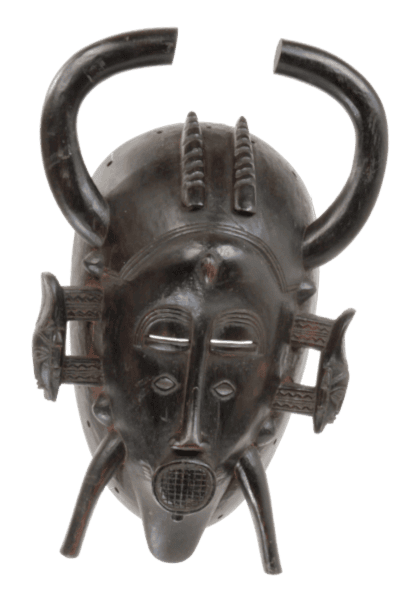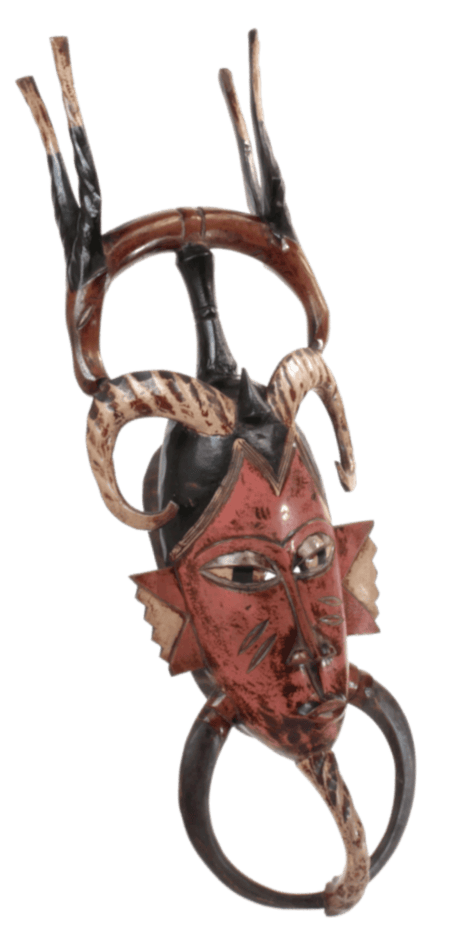No products in the cart.
About the Artisans
Making Masks in West & Central Africa

African Mask Cultures
Of all African tribal art, mask making may be the most diverse. Though mask carving is especially prevalent in Western and Central Africa, it is present throughout the continent in various forms.
African masks are usually associated with a specific ceremony or society, some secret and some public which preserve traditional culture. During dances and ceremonies, masks are danced with great vigor and enthusiasm and are worn along with traditional clothing or costumes.
Symbolism is common in masks, each type representing something of cultural significance.
It is common for tribes near each other to combine their traditions, commonly through inter-marrying, causing mask styles and ceremonies to evolve though years of cultural exchange.

Types of Masks
Despite the perception that all masks are worn on the face of a masquerader, different masks are meant to be worn in different ways, which is why many types don’t have eyeholes. Plank masks of West Africa (such as those made by the Bwa and nearby tribal groups) are worn on top of the head and the wearer bends down to display the face to the audience. Senufo kpeliye’e masks are made to be worn on the forehead, while small West African masks are sometimes worn on the body (arms, legs, hips and elsewhere) as a part of the traditional costume.
Artistic Technique
There is a huge variety of African mask styles, even within the same tribe, sub-tribe, or clan.
While some masks are known for simplicity and minimalism, others are noted for elaborate design and intricate carving. For example, even though the Guro and Baule people are closely related, the Forest Spirit masks of the Guro are elaborate while the kplekple masks of the Baule are not.
Caring for Your Mask
As with any wooden object, keep out of direct sunlight. African masks will often possess a fairly high degree of patina – small dings, scrapes, cracks, and repairs done in Africa. Due to their tribal importance, masks are not discarded, they are cherished, repaired and will often show more patina the older they are. This African patina can be sought after by collectors.
About West Africa

The United Nations defines Western Africa as the 16 countries of Benin, Burkina Faso, Cape Verde, The Gambia, Ghana, Guinea, Guinea-Bissau, Ivory Coast, Liberia, Mali, Mauritania, Niger, Nigeria, Senegal, Sierra Leone and Togo.
Despite the wide variety of cultures in West Africa, there are general similarities in dress, cuisine, music and culture that are not shared extensively with groups outside the geographic region. This long history of cultural exchange predates the colonization era of the region and can be approximately placed at the time of the Ghana Empire (c. 300 BCE until c. 1100 BCE), or perhaps earlier.
The population of West Africa is estimated at 381 million people as of 2018. The Yoruba, Igbo, Fulani, Akan, Wolof and Tiv ethnic groups are the largest and most influential. In the central Sahara, Mandinka or Mande groups are most significant. The Hausa are found in more northerly parts of the region nearest to the Sahara, and the Songhai, Kanuri and Zarma are found in the eastern parts of West Africa bordering Central Africa.
Islam is the predominant religion of the West African interior and the far west coast of the continent (60% of West Africans) and was introduced to the region by traders in the 9th century. Traditional African religions (noting the many different belief systems) are the oldest belief systems among the populations of this region, and include Akan religion, Yoruba religion, Odinani, and Serer religion. They are spiritual but also linked to the historical and cultural heritage of the people. Although traditional beliefs vary from one place to the next, there are more similarities than differences. In 2010 around 36.5% of Western Africans identified as Christians. Christianity was largely introduced from the late 19th century onward, when missionaries from European countries brought the religion to the region.
Source: Wikipedia
Shop with a conscience. Choose Fair Trade goods.
All of our African baskets are verified Fair Trade, because we believe that indigenous people around the world should be compensated fairly for their amazing work.